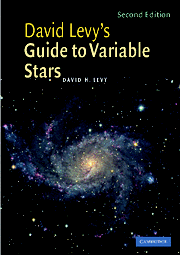Book contents
- Frontmatter
- Contents
- Foreword to the first edition
- Preface
- Acknowledgments
- Part I Getting to know the sky
- Part II Getting to know the variables
- 5 Meeting the family
- 6 Getting started with Cepheids
- 7 Algol, the demon of autumn
- 8 How to estimate a variable
- 9 Names and records
- 10 How your observations help us understand a variable star
- 11 Observing hints
- 12 Observing with CCDs
- 13 Stately and wonderful
- 14 Stars of challenge
- 15 Bright, easy, and interesting
- 16 Betelgeuse: easy and hard
- 17 Not too regular
- 18 Nova? What nova?
- 19 Supernovae
- 20 Clyde Tombaugh's star and the family of cataclysmic variables
- 21 A nova in reverse?
- 22 RU Lupi?
- 23 Orion, the star factory
- 24 Other variable things
- 25 The Sun
- Part III Suggested variables for observation throughout the year
- Part IV A miscellany
- Index
6 - Getting started with Cepheids
from Part II - Getting to know the variables
Published online by Cambridge University Press: 05 August 2012
- Frontmatter
- Contents
- Foreword to the first edition
- Preface
- Acknowledgments
- Part I Getting to know the sky
- Part II Getting to know the variables
- 5 Meeting the family
- 6 Getting started with Cepheids
- 7 Algol, the demon of autumn
- 8 How to estimate a variable
- 9 Names and records
- 10 How your observations help us understand a variable star
- 11 Observing hints
- 12 Observing with CCDs
- 13 Stately and wonderful
- 14 Stars of challenge
- 15 Bright, easy, and interesting
- 16 Betelgeuse: easy and hard
- 17 Not too regular
- 18 Nova? What nova?
- 19 Supernovae
- 20 Clyde Tombaugh's star and the family of cataclysmic variables
- 21 A nova in reverse?
- 22 RU Lupi?
- 23 Orion, the star factory
- 24 Other variable things
- 25 The Sun
- Part III Suggested variables for observation throughout the year
- Part IV A miscellany
- Index
Summary
Delta Cephei
To get an idea of what variable-star observing is all about, here are two active, easily found stars that we will observe informally. The first is Delta Cephei, an ideal star to begin with for several reasons. It is part of a bright and compact star group, is usually around magnitude 4, and is an active star, always offering something interesting to watch.
Delta Cephei's variation was discovered by John Goodricke in 1784 (see Chapter 32), and it is the star for which all the Cepheid variables are named. The variation in this giant star is small but extremely regular with a period of several days. It is also typical that this star enjoys a leisurely decline to minimum that is followed by a rapid rise to maximum.
At maximum, Delta Cephei is easily visible at magnitude 3.5, and at minimum it shines at 4.4. If you observe every night or two you will soon see how it falls, then rises, week after week.
Notice the two stars Zeta and Epsilon in Fig. 6.1 and in the sky. Which is brighter? Let us give Zeta Cephei an arbitrary value of “1” and Epsilon a value of “5”. Each night estimate the brightness of Delta Cephei as follows:
– as bright as Zeta
– slightly fainter than Zeta
– halfway between Zeta and Epsilon
– slightly brighter than Epsilon
– as faint as Epsilon
Even though we are not using actual magnitude values here, we still estimate to better than 0.2 magnitude.
- Type
- Chapter
- Information
- David Levy's Guide to Variable Stars , pp. 30 - 34Publisher: Cambridge University PressPrint publication year: 2005

